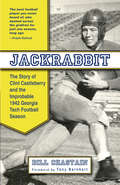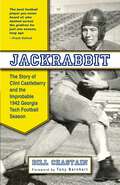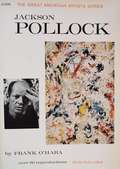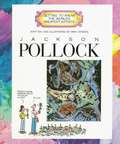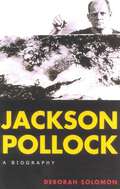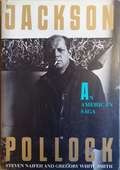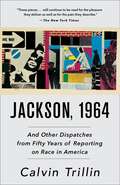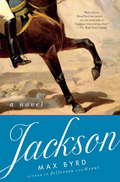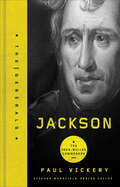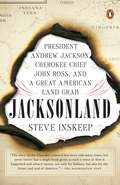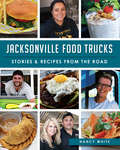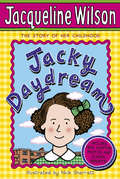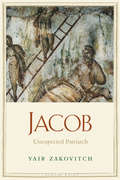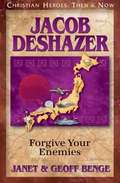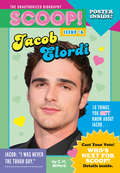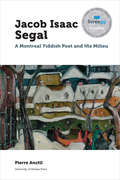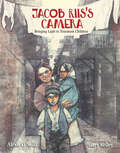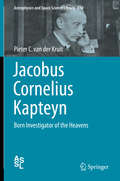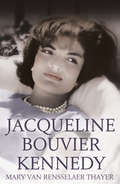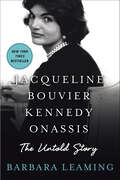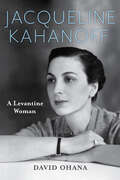- Table View
- List View
Jackie: Public, Private, Secret
by J. Randy TaraborrelliTHE INSTANT NEW YORK TIMES BESTSELLER!From the New York Times bestselling author of Jackie, Janet & Lee comes a fresh and often startling look at the life of the legendary former first lady, Jacqueline Kennedy Onassis.Based on hundreds of interviews with friends, family, and lovers over a thirty-year period—as well as previously unreleased material from the JFK Library—Kennedy historian J. Randy Taraborrelli paints an unforgettable new portrait of a woman whose flaws and contradictions only serve to make her even more iconic. “I have three lives,” Jackie told a former lover, “public, private and secret.” In this revealing biography, readers will become intimately familiar with all three. New insights from the book include:· Jackie’s cold feet before her wedding to Jack Kennedy and her secret plan to avoid moving into the White House with him.· Jackie's plan to meet with the woman with whom her husband, Aristotle Onassis, was again having an affair, Maria Callas…and why, in the end, she decided against it.· The truth about the nude photos of Jackie which scandalized her in the 1970s…and which family member had betrayed her by selling them.· Her unusual relationship with Maurice Templesman, which was never what outsiders believed it to be.· The never-before-reported, last-ditch efforts to save Jackie’s life with experimental cancer treatments, and the doctor who wouldn’t risk jail time in order to treat her.Decades after her death and over sixty years after the assassination of President Kennedy, Jackie delivers the last word on one of the most famous women in the world.
Jackie’s Nine: Jackie Robinson's Values to Live By
by Sharon RobinsonShort essays, by a variety of writers, that illustrate the nine values that Sharon Robinson associated with her father: Courage, determination, teamwork, persistence, integrity, citizenship, justice, commitment, and excellence.
Jackrabbit: The Story Of Clint Castleberry And The Improbable 1942 Georgia Tech Season
by Bill ChastainHe ran like a crazed jackrabbit, according to one awe-struck sportswriter. Clint Castleberry was already an Atlanta-area football sensation when he arrived at Georgia Tech in 1942, and in one meteoric college season he became a national sports hero as well. He was the first college freshman ever to be voted All-American. At least one Heisman Trophy was all but certain. Though weighing just 155 pounds, he seemed destined to become one of the greatest tailbacks in college football history. But then World War II intervened, and Castleberry became, instead, another young man whose destiny was cut short. His #19 is the only number ever retired in the illustrious history of Georgia Tech football. Bill Chastain weaves Clint Castleberry’s story around other legends of Georgia Tech football--including John Heisman, William Alexander, and Bobby Dodd—to create a glorious portrait of a proud football tradition and America’s Greatest Generation.
Jackrabbit: The Story of Clint Castleberry and the Improbable 1942 Georgia Tech Football Season
by Bill ChastainClint Castleberry was already an Atlanta-area football sensation when he arrived at Georgia Tech in 1942, and in one meteoric college season he became a national sports hero as well. He was the first college freshman ever to be voted All-American. At least one Heisman Trophy was all but certain. Though weighing just 155 pounds, he seemed destined to become one of the greatest tailbacks in college football history. But then World War II intervened, and Castleberry became, instead, another young man whose destiny was cut short. His #19 is the only number ever retired in the illustrious history of Georgia Tech football. Bill Chastain weaves Clint Castleberry's story around other legends of Georgia Tech football--including John Heisman, William Alexander, and Bobby Dodd—to create a glorious portrait of a proud football tradition and America's Greatest Generation.
Jackson Pollock
by Frank O’haraThis slim, but richly illustrated, biography of Jackson Pollock has stood the test of time since its first publication in 1959. Still a sound, but laudatory, study of all of Pollock's periods; which are weighed and appreciated in chronological order. Frank O'Hara was a well-known and universally respected poet who was an integral part of the New York artistic scene until his death in 1966.
Jackson Pollock (Getting to Know the World's Greatest Artists)
by Mike VeneziaRecounts the artist's childhood and education, describes influences on his work, and looks at several of his major paintings
Jackson Pollock: A Biography
by Deborah SolomonDeborah Solomon's biography sets Jackson Pollock in his time and portrays him as a shy, often withdrawn person, full of insecurities and self-doubts, and frequently unable to express himself about his art or its meaning. Solomon interviewed two hundred people who knew Pollock and his work and she has drawn extensively on Pollock's own writings and other personal papers. She examines the artist's relationships with his family; his wife and fellow artist Lee Krasner; art patron Peggy Guggenheim; the painters Willem de Kooning, Mark Rothko, and many more.
Jackson Pollock: An American Saga
by Gregory W. Smith Steven W. NaifehBased on family letters and documents, lengthy interviews with his widow, Lee Krasner, as well as his psychologists and psychoanalysts, this book explodes the myths surrounding his death in 1956. <P><P> Pulitzer Prize Winner
Jackson, 1964: And Other Dispatches from Fifty Years of Reporting on Race in America
by Calvin TrillinFrom bestselling author and beloved New Yorker writer Calvin Trillin, a deeply resonant, career-spanning collection of articles on race and racism, from the 1960s to the present In the early sixties, Calvin Trillin got his start as a journalist covering the Civil Rights Movement in the South. Over the next five decades of reporting, he often returned to scenes of racial tension. Now, for the first time, the best of Trillin's pieces on race in America have been collected in one volume. In the title essay of Jackson, 1964, we experience Trillin's riveting coverage of the pathbreaking voter registration drive known as the Mississippi Summer Project--coverage that includes an unforgettable airplane conversation between Martin Luther King, Jr., and a young white man sitting across the aisle. ("I'd like to be loved by everyone," King tells him, "but we can't always wait for love.") In the years that follow, Trillin rides along with the National Guard units assigned to patrol black neighborhoods in Wilmington, Delaware; reports on the case of a black homeowner accused of manslaughter in the death of a white teenager in an overwhelmingly white Long Island suburb; and chronicles the remarkable fortunes of the Zulu Social Aid & Pleasure Club, a black carnival krewe in New Orleans whose members parade on Mardi Gras in blackface. He takes on issues that are as relevant today as they were when he wrote about them. Excessive sentencing is examined in a 1970 piece about a black militant in Houston serving thirty years in prison for giving away one marijuana cigarette. The role of race in the use of deadly force by police is highlighted in a 1975 article about an African American shot by a white policeman in Seattle. Uniting all these pieces are Trillin's unflinching eye and graceful prose. Jackson, 1964 is an indispensable account of a half-century of race and racism in America, through the lens of a master journalist and writer who was there to bear witness.Advance praise for Jackson, 1964 "An exceptional collection [from] master essayist Trillin . . . exposing through perceptive observations and nuanced humor the insidious nature of discriminatory practices."--Booklist (starred review)"Trillin, a regular contributor to the New Yorker since 1963, collects his insights and musings on race in America in previously published essays from over fifty years of reporting. . . . What's shocking is how topical and relatively undated many of these essays seem today."--Publishers Weekly (starred review)"The author of some thirty titles, Trillin revisits the last half-century's racial struggles in various regions of the country, and readers are likely to come away thinking, 'so much has not really changed all that much.' . . . Haunting pieces that show how our window on the past is often a mirror."--Kirkus Reviews Praise for Calvin Trillin"That rarity, reportage as art."--The New York Times "[A writer] of painterly, impeccably crafted journalism."--People "Trillin is perhaps the finest reporter in America."--The Miami Herald "If Truman Capote invented the nonfiction novel, as he claimed, and Norman Mailer devised variations on it, Trillin has perfected the nonfiction short story; moreover, his craftsmanship can contend with that of either Capote or Mailer at their best."--Kirkus ReviewsFrom the Hardcover edition.
Jackson: A Novel
by Max ByrdIn this sweeping, marvelously written novel, Max Byrd, the celebrated author of Jefferson and Grant, presents a superb portrait of Andrew Jackson, a President remembered for his strong will and tempestuous nature--and regarded as "the most dangerous man in America" by none other than Thomas Jefferson. He became a legend during the War of 1812. He was a slave owner, land speculator, and Indian fighter. He stole another man's wife, murdered men in duels, and ordered military executions. But Andrew Jackson was also an impassioned supporter of universal suffrage and an ardent believer in the will of the people. Here the story of our controversial seventh President is told from a variety of viewpoints, including that of a young writer named David Chase who discovers, on the eve of the presidential election, a secret that could change the future of the nation. Along the way, readers encounter such notable figures as John Quincy Adams, Aaron Burr, and Sam Houston, and bear witness to an America in transition--and a man as unpredictable as democracy itself. "Max Byrd's historical novels about the third and seventh presidents bring both men alive in ways that only a literary imagination can."--George F. Will, The Washington Post "With Jackson, [Max] Byrd has vaulted . . . into the front rank of American historical novelists."--The Wall Street Journal "Vivid and compelling . . . a convincing and intriguing portrait of Jackson as he might have been."--The Plain Dealer "Full of action, emotion, and insight, Max Byrd's Jackson deserves to stand with the finest works of historical fiction."--San Francisco Chronicle "Grounded in excellent, detailed historical research, Byrd paints a rich, multilayered portrait."--Chicago TribuneFrom the Trade Paperback edition.
Jackson: The Iron-Willed Commander (The Generals Series)
by Paul VickeryA gripping account of the man who emerged as a national hero through his military successes—and became the seventh President of the United States.Orphan. Frontiersman. President. The rise of Andrew Jackson to the highest office in America has become a legend of leadership, perseverance, and ambition. Central to Jackson’s historic climb—long before the White House—was his military service. Scarred permanently as a child by the sword of a British soldier, Jackson grew into an unwavering leader, a general whose charisma and sheer force of personality called to mind those of George Washington a generation earlier.As commander of the Tennessee militia in the War of 1812, Jackson became “Old Hickory,” the indomitable spearhead in a series of bloody conflicts with the Creek on the southwest frontier. Slight of frame with silver hair that seemed to stand on command, Jackson once stood down a mutinous brigade as an army of one. Then came New Orleans. Author Paul Vickery chronicles Jackson’s defining battle and the decisions a single, impassioned commander made to ensure a growing nation could, once and for all, be free of British might. The hero of New Orleans infused America, for the first time, with a sense of nationalism.Jackson was decisive and unforgiving, a commander firmly in his element. In his own words, “One man with courage makes a majority.” The lessons of one extraordinary general endure.
Jacksonland: President Andrew Jackson, Cherokee Chief John Ross, and a Great American Land Grab
by Steve InskeepJacksonland is the thrilling narrative history of two men--President Andrew Jackson and Cherokee chief John Ross--who led their respective nations at a crossroads of American history. Five decades after the Revolutionary War, the United States approached a constitutional crisis. At its center stood two former military comrades locked in a struggle that tested the boundaries of our fledgling democracy. Jacksonland is their story. One man we recognize: Andrew Jackson--war hero, populist, and exemplar of the expanding South--whose first major initiative as president instigated the massive expulsion of Native Americans known as the Trail of Tears. The other is a half-forgotten figure: John Ross--a mixed-race Cherokee politician and diplomat--who used the United States' own legal system and democratic ideals to oppose Jackson. Representing one of the Five Civilized Tribes who had adopted the ways of white settlers--cultivating farms, publishing a newspaper in their own language, and sending children to school--Ross championed the tribes' cause all the way to the Supreme Court. He gained allies like Senator Henry Clay, Chief Justice John Marshall, and even Davy Crockett. In a fight that seems at once distant and familiar, Ross and his allies made their case in the media, committed civil disobedience, and benefited from the first mass political action by American women. Their struggle contained ominous overtures of later events like the Civil War and set the pattern for modern-day politics. At stake in this struggle was the land of the Five Civilized Tribes. In shocking detail, Jacksonland reveals how Jackson, as a general, extracted immense wealth from his own armies' conquest of native lands. Later, as president, Jackson set in motion the seizure of tens of millions of acres--"Jacksonland"--in today's Deep South. Jacksonland is the work of renowned journalist Steve Inskeep, cohost of NPR's Morning Edition, who offers here a heart-stopping narrative masterpiece, a tragedy of American history that feels ripped from the headlines in its immediacy, drama, and relevance to our lives. Harrowing, inspiring, and deeply moving, Inskeep's Jacksonland is the story of America at a moment of transition, when the fate of states and nations was decided by the actions of two heroic yet tragically opposed men. CANDICE MILLARD, author of Destiny of the Republic and The River of Doubt"Inskeep tells this, one of the most tragic and transformative stories in American history, in swift, confident, colorful strokes. So well, and so intimately, does he know his subject that the reader comes away feeling as if Jackson and Ross's epic struggle for the future of their nations took place yesterday rather than nearly two hundred years ago." From the Hardcover edition.
Jacksonville Food Trucks: Stories & Recipes from the Road (American Palate)
by Nancy WhiteFood trucks in Jacksonville are a smashing success. The early popularity of trucks like Corner Taco and On the Fly set the stage for a mobile dining revolution. Innovators such as Mike Field and Jax Truckies supplied the vision and passionately advocated for the cause. From Beer Cheese Soup to Chicken Madras, the astounding variety of menus, themes and trucks means there's something for all locals to enjoy. Author and "Nourish the Beast" blogger Nancy White includes fascinating stories and mouth-watering recipes as she chronicles the rise of food trucks on Florida's First Coast.
Jacky Daydream
by Jacqueline WilsonLots of Jacqueline Wilson's characters are well-known and well-loved by thousands of readers: Hetty Feather, Ruby and Garnet, Pearl and Jodie, Elsa, Lily and, of course, the brilliant Tracy Beaker! But how much do you know about Jacqueline herself? Jacqueline takes a look back at her own childhood and teenage years in this captivating story of friendships, loneliness, books, family life and much more. She explores her past with the same warmth and lightness of touch that make her novels so special. Best of all, she reveals how she was always determined to be a writer; from the very first story she wrote, it was clear that this little girl had a very vivid imagination! But who would've guessed that she would grow up to be the mega-bestselling, award-winning Jacqueline Wilson?With original photographs and new illustrations by Nick Sharratt, this book is a delight for all of Jacky's fans, and a treat for any new readers too.
Jacob
by Yair ZakovitchA powerful hero of the Bible, Jacob is also one of its most complex figures. Bible stories recounting his life often expose his deception, lies, and greed--then, puzzlingly, attempt to justify them. In this book, eminent biblical scholar Yair Zakovitch presents a complete view of the patriarch, first examining Jacob and his life story as presented in the Bible, then also reconstructing the stories that the Bible writers suppressed--tales that were well-known, perhaps, but incompatible with the image of Jacob they wanted to promote. Through a work of extraordinary "literary archaeology," Zakovitch explores the recesses of literary history, reaching back even to the stage of oral storytelling, to identify sources of Jacob's story that preceded the work of the Genesis writers. The biblical writers were skilled mosaic-makers, Zakovitch shows, and their achievement was to reshape diverse pre-biblical representations of Jacob in support of their emerging new religion and identity. As the author follows Jacob in his wanderings and revelations, his successes, disgraces, and disappointments, he also considers the religious and political environment in which the Bible was written, offering a powerful explication of early Judaism.
Jacob Deshazer: Forgive Your Enemies (Christian Heroes Then & Now)
by Janet Benge Geoff BengeThree thousand feet above China, it was Jake's turn to jump. He slid his pistol, knife, and ration packets into the pockets of his leather jacket and edged toward the open hatch of the B-52 bomber. He checked the tension on the harness of his parachute, made sure the handle of the ripcord was free, and then began lowering himself out of the hatch and into the darkness. One of the famous Doolittle Raiders who first attacked Japan after the bombing of Pearl Harbor, Jacob DeShazer knew this one-way mission was dangerous. Indeed, it led to his capture as a prisoner of war. Beaten, malnourished, and alone in his cell, Jacob was given a Bible - and far away from home, this American soldier became a Christian. After the war, Jacob returned to Japan and served his former enemy for thirty years as a missionary. His testimony of forgiveness and reconciliation - of love over hate - inspires a powerful gospel message for our lives today.
Jacob Elordi: Issue #6 (Scoop! The Unauthorized Biography #6)
by C. H. MitfordIntroducing a new series of unauthorized biographies on the world's biggest names and rising stars in entertainment, sports, and pop culture! Complete with quizzes, listicles, trivia, and a full-color pull-out poster of the star, this is the definitive collection to get the full Scoop! and more on your favorite celebrities.Jacob Elordi is on his way to superstar status:From his breakout role as Noah in The Kissing Booth to his steamy HBO debut in Euphoria followed by an ad campaign for Calvin Klein underwear, things are really starting to heat up for this Aussie actor. But what's next?Get the full Scoop! and more on Jacob Elordi, Hollywood's next heartthrob.
Jacob Green’s Revolution: Radical Religion and Reform in a Revolutionary Age
by S. Scott RohrerPart biography and part microhistory, Jacob Green’s Revolution focuses on two key figures in New Jersey’s revolutionary drama—Jacob Green, a radical Presbyterian minister who advocated revolution, and Thomas Bradbury Chandler, a conservative Anglican minister from Elizabeth Town who was a leading loyalist spokesman in America. Both men were towering intellects who were shaped by Puritan culture and the Enlightenment, and both became acclaimed writers and leading figures in New Jersey—Green for the rebelling colonists, Chandler for the king. Through their stories, this book examines the ways in which religion influenced reform during a pivotal time in American history.
Jacob Isaac Segal: A Montreal Yiddish Poet and His Milieu (Canadian Studies)
by Pierre AnctilTranslated by Vivian Felsen Finalist, 2018 Governor General’s Literary Awards (GGBooks), Translation category Born in the Ukraine in 1896, and settling in Montreal in 1910, Segal became one of the first Yiddish writers in Canada. His poetry, infused with lyricism and mysticism, along with the numerous essays and articles he penned, embodied both a rich literary tradition and the modernism of his day. Pierre Anctil has written so much more than a biography. For the first time, Segal’s poetic production is referenced, translated and rigorously analyzed, and includes over 100 pages of appendices, shedding light on the artistic, spiritual, cultural and historical importance of his oeuvre. By introducing the reader to the poet’s work through previously unpublished translations, Anctil demonstrates that in many respects it reflects the history of the Jewish immigrants who arrived in North America from Russia, the Ukraine and Poland at the beginning of the 20th century, as well as the tragic experiences of Jewish intellectual refugees of the interwar period. This admirably written, sweeping yet subtle, work will appeal both to scholars and to a broader audience. The original French version was awarded the prestigious 2014 Canada Prize in the Humanities by the Canadian Federation for the Humanities and Social Sciences.
Jacob Riis's Camera: Bringing Light to Tenement Children
by Alexis O'NeillThis revealing biography of a pioneering photojournalist and social reformer Jacob Riis shows how he brought to light one of the worst social justice issues plaguing New York City in the late 1800s--the tenement housing crisis--using newly invented flash photography.Jacob Riis was familiar with poverty. He did his best to combat it in his hometown of Ribe, Denmark, and he experienced it when he immigrated to the United States in 1870. Jobs for immigrants were hard to get and keep, and Jacob often found himself penniless, sleeping on the streets or in filthy homeless shelters. When he became a journalist, Jacob couldn't stop seeing the poverty in the city around him. He began to photograph overcrowded tenement buildings and their impoverished residents, using newly developed flash powder to illuminate the constantly dark rooms to expose the unacceptable conditions. His photographs inspired the people of New York to take action. Gary Kelley's detailed illustrations perfectly accompany Alexis O'Neill's engaging text in this STEAM title for young readers.
Jacob's Promise (Fountas & Pinnell Classroom, Guided Reading)
by Julie WeissNIMAC-sourced textbook. A Hard Life. As a young man, Jacob Riis spent time living on the streets. He often had no job and no home. What chance did he have for a better life?
Jacobus Cornelius Kapteyn
by Pieter C. van der KruitJacobus C. Kapteyn (1851-1922) was a Dutch astronomer who contributed heavily to major catalogs of star positions, such as the Cape Photographic Durchmusterung and the Harvard-Groningen Durchmusterung, and arranged extensive international collaboration through his Plan of Selected Areas. He contributed to the establishment of statistical astronomy and structure and dynamics of the Sidereal System. All aspects of Kapteyn's life are discussed, from his birth in Barneveld, the Netherlands, to his death in Amsterdam, and his entire resume of scientific achievements in between. Kapteyn had some conflicts with others in his field, especially after the world became divided on how to handle scientific contributions from Germany post-World War I. Both Kapteyn's struggles and achievements are written against the backdrop of both the historical context of the world at that time as well as the scientific one.
Jacqueline Bouvier Kennedy
by Mary Van Rensselaer ThayerJacqueline Bouvier Kennedy, first published in 1961, is biography of the first-lady, from her early childhood to her meeting and marriage with John F. Kennedy. The book ends with the family’s move into the White House (and before the President’s tragic assassination in November 1963). Author Mary Rensselaer Thayer worked closely with Mrs. Kennedy to produce the book, and it is reported that Jacqueline prepared much of the initial draft. Included are 35 pages of illustrations.
Jacqueline Bouvier Kennedy Onassis: The Untold Story
by Barbara LeamingThe instant New York Times and USA Today bestseller!The untold story of how one woman's life was changed forever in a matter of seconds by a horrific trauma.Barbara Leaming's extraordinary and deeply sensitive biography is the first book to document Jacqueline Kennedy Onassis' brutal, lonely and valiant thirty-one year struggle with post-traumatic stress disorder (PTSD) that followed JFK's assassination.Here is the woman as she has never been seen before. In heartrending detail, we witness a struggle that unfolded at times before our own eyes, but which we failed to understand.Leaming's biography also makes clear the pattern of Jackie's life as a whole. We see how a spirited young woman's rejection of a predictable life led her to John F. Kennedy and the White House, how she sought to reconcile the conflicts of her marriage and the role she was to play, and how the trauma of her husband's murder which left her soaked in his blood and brains led her to seek a very different kind of life from the one she'd previously sought.A life story that has been scrutinized countless times, seen here for the first time as the serious and important story that it is. A story for our times at a moment when we as a nation need more than ever to understand the impact of trauma.
Jacqueline Kahanoff: A Levantine Woman (Perspectives on Israel Studies)
by David OhanaJacqueline Kahanoff: A Levantine Woman is the first intellectual biography of this remarkable Egyptian-Jewish intellectual, whose work has secured her place in literary pantheon as a herald of Levantine, Mediterranean, and transnational culture. Growing up Jewish in cosmopolitan Egypt in the 1920s and 1930s, Jacqueline Kahanoff experienced a bustling Middle East enriched by diverse languages, religions, and peoples who nonetheless were deeply connected to each other through history, business, daily practices, and shared landscape. At the age of twenty-four, Kahanoff immigrated to the United States. Her stories, essays, and short autobiographical novel attest to her penchant to cross boundaries, generations, social classes, sexes, and Western and Eastern constructs. After immigrating to Israel in the early 1950s, she critically addressed the country's "provinciality" and "ethnic nationalism" as seen through her conception of a transnational Levantine culture. Through many writings, Kahanoff set forth her distinctive vision of Israel as a Mediterranean country with a broad, multicultural Levantine identity. Drawing on an extensive array of sources, ranging from interviews with Jacqueline Kahanoff's acquaintances and contemporaries to unpublished writings, David Ohana explores her fascinating life and intellectual journey from Cairo to Tel Aviv. The encompassing vision of a Levantine Israel made Kahanoff the initiator of a different cultural possibility, more extensive than that offered in her time, and also, perhaps, than is offered today.


